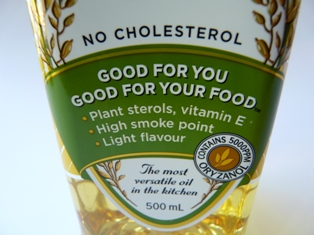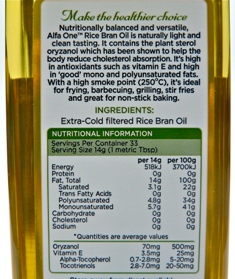Product review: Rice Bran Oil
Written by Catherine Saxelby
on Monday, 26 July 2010.
Tagged: fat, healthy cooking, healthy eating, oil, review

With all the advertising hype targeting heart disease and high cholesterol and with some websites proclaiming it the "world's healthiest oil", best for body builders and even menopausal women, rice bran oil is the oil I get most questions about. How much healthier is it? What's it like to cook with? And how does it taste? Here are some answers...
First a little background
Initially launched in 2006 in New Zealand, rice bran oil (brand name Alfa One) experienced strong growth and quickly became NZ's top brand of Rice Bran Oil. Not long after the NZ launch, it was launched in Australia.
Despite its NZ roots, it was, and still is, produced and owned by a Thai company Kamolkij Group. Kamolkij appointed Old Fashioned Foods to market the Alfa One oil in 2004. The oil is produced and bottled in Thailand and takes approximately 18 days in shipping before landing on Aussie ground.
How rice bran oil is made
Rice bran is rich in natural oil (15 to 20% oil). The oil is extracted from the bran and germ - the most nutritious parts of the rice grain - representing only 8% of the total weight of the kernel, but containing roughly three-quarters of the total oil.
Rice bran oil side-by-side with three other oils
Alfa One's trade mark slogan "Good for you, Good for your food" stands out along with its label claims of being ‘The most versatile oil in the kitchen' with ‘No cholesterol'. On the supermarket shelf, it looks an attractive option. I lined it up against olive oil, canola and grapeseed oil using these mainstream brands:
- Lupi Olive Oil
- Crisco Canola Oil
- Azalea Grapeseed Oil
Rating
Taste: 8/10
I found Rice Bran Oil the most subtle in taste - almost neutral - compared to olive, canola and grapeseed oils. This neutral flavour doesn't interfere with the taste of other ingredients so it's good for delicate flavours like seafood, white wine-based sauces, tempura or desserts.
My first impression was that this was a ‘runny oil'. The advantage of this low viscosity is that a little goes a long way to coat food and pans. This may only save as little as a teaspoon each time but it does add up and so do the kilojoules saved! This also means foods absorbs less oil - particularly when compared to olive oil.
For roasting, I liked rice bran oil better than either olive oil - which sometimes leaves a thick oily residue on food - or canola, and on par with grapeseed, no doubt due to its high smoke point.
When it came to salad dressings, rice bran oil lost out to the olive oil (mind you, so did the others). Olive oil's fresh, distinctive taste was instantly recognizable and pleasant. The others tasted just like any vegetable oil. I also believe if you are going to eat oil uncooked, you're better off with a cold-pressed oil, so extra-virgin, cold-pressed is my choice.
Nutrition: 7/10
Nutritionally, rice bran oil is a healthy oil suitable for anyone wishing to lower their cholesterol. Unlike other kitchen oils, it has an unusual mix of fatty acids, containing around half polyunsaturated and half monounsaturated fats (other oils tend to be mainly one or the other). Olive oil is high in monounsaturates, while grapeseed and sunflower oil have more polyunsaturated. Rice bran oil has been tested in a number of studies (including human studies).
Here are the plusses and minuses nutritionally:
On the plus side
 1. Oryzanol
1. Oryzanol
Much has been made of rice bran oil's naturally-occurring oryzanol (technically gamma-oryzanol), a plant sterol unique to rice that reduces the absorption of cholesterol into the body and so lowers blood cholesterol levels. It also acts as an antioxidant.
Oryzanol has been suggested for conditions such as menopausal symptoms, mild anxiety, stomach upset, as a sports supplement and conditioning supplement for horses. There is no real evidence that it works for any of these.
According to the Heart Foundation, a daily intake of 2 to 3 grams of plant sterols has been shown to lower cholesterol levels by up to 10 per cent. Plant sterols are added to cholesterol-lowering margarines such as Logicol and Pro-activ. You'll get 0.8 g from a teaspoon of these spreads which is more than the 0.12 g you get from a teaspoon of rice bran oil. The amount present in rice bran oil is small (typically 0.5 to 1%) so unlikely to have a notable cholesterol-lowering effect.
2. Vitamin E
Rice bran oil contains a little vitamin E as tocopherol, although not as much as in sunflower or wheatgerm oil. It also has tocotrienols, alternative forms of Vitamin E, which add to its total content.
3. Not hydrogenated
Trace amounts of trans fats occur naturally in some oils and you'll see them listed on the label. They're not the result of hydrogenation (see my article on Trans fat) but of heating during processing. Looking at the four oils, all are virtually free from trans fats which means less than 1% (grapeseed has 0.9% and canola has 0.8% or 0.8g per 100g).
According to Heart Foundation criteria, no more than 1% of the fat in oils should come from trans fat and no more that 20% from saturated fats but rice bran oil contains 22% saturated fat.
|
Oil type |
Total |
Saturated fat (%) |
Monounsaturated fat (%) |
Polyunsaturated fat (%) |
Trans fat (%) |
| Rice bran |
97* |
22 | 41 | 34 | 0 |
| Olive | 100 | 15 | 75 | 10 | 0 |
| Canola | 100 | 9 | 60 | 30 | 1 |
| Grapeseed | 101 | 10 | 25 | 65 | 1 |
|
Heart Foundation suggestions |
n/a | <20 | Not set | Not set | <1 |
All values rounded up to the nearest whole number. *Other non-saponifiables and waxes make up the remaining 3%.
4. High smoke point
Rice bran oil has a high smoke point of 250°C, so you can cook at high temperatures before it starts to burn or smoke - a great advantage over other oils.
Minusses
There are three nutritional downsides that you need to be aware of:
1. Industrially processed, NOT cold-pressed
The oil extracted from rice bran goes rancid quickly once pressed. Unlike olive oil, it ISN'T cold-pressed. To refine it, a solvent is used to extract the oil from the bran which is later evaporated off (and tested post-production for residual solvents to double check for traces). That's followed by neutralisation, bleaching, winterisation and de-odourisation steps, as with most other oils. This creates refined and stabilized oil, bringing about a long shelf life and high smoke point. However, what you lose is the "naturalness" of the oil.
| Extra-Cold Filtered Rice Bran Oil |

Rice bran oil's ingredient list appears straightforward with no additives (see above) but it's not as ‘natural' as you would think. I found the term ‘extra-cold filtered' a little confusing.
At first glance you could confuse this with ‘extra-virgin cold pressed', a well-known method of producing extra-virgin olive oil. Yet ‘extra-cold filtered'? I wasn't sure what benefits existed of oil being extra-cold during filtration - particularly when rice bran oil is subjected to high temperatures during the extraction phase prior to the filtration.
So I got on the phone to Alfa One's marketing company Old Fashioned Foods and received the following information from Brand Manager William Papesch. "Cold filtering removes hard fats, which are the saturated fats. Cold filtration is common across many products in the food industry, particularly beverages. It is designed to make filtration easier as all hard solid matter solidifies and can be separated quickly." Got it! Just don't be fooled. It's NOT the same as extra virgin cold-pressed olive oil!
2. Higher in saturated fat
At 22% saturated fat, rice bran oil is at the high end for oils and above the Heart Foundation's criteria. It's on a par with cottonseed oil at 27% but higher than olive oil at 15% saturated fat, grapeseed 9% and canola 8%.
3. High in linoleic acid, low in omega-3
Rice bran oil has little omega-3 (alpha-linolenic acid) and lots of omega-6 (linoleic acid). However this low ALA combined with a higher level of saturates gives rice bran oil excellent frying qualities, long stability and fry life without hydrogenation, so this is where it shines.
Convenience: 8/10
 Good package features - Alfa One's rice bran oil comes in a small 500 mL plastic bottle, which is a handy size for small households, smaller than the usual 750 mL or 1 Litre bottle. The bottle design is practical with a small circumference so you can get a good grip when pouring. It has a tight-fitting plastic screwtop cap with an easy-pour lip, preventing drips. Plus it's light and doesn't break if dropped.
Good package features - Alfa One's rice bran oil comes in a small 500 mL plastic bottle, which is a handy size for small households, smaller than the usual 750 mL or 1 Litre bottle. The bottle design is practical with a small circumference so you can get a good grip when pouring. It has a tight-fitting plastic screwtop cap with an easy-pour lip, preventing drips. Plus it's light and doesn't break if dropped.
The bottle has recycle code number '1' (PETE) on the base. For this type of plastic, there is no strong evidence that chemicals such as polyvinyl chlorides (PVCs) can leach into the oil as the bottle ages. Still glass bottles pose no such queries.
The bottom line
Rice bran oil is perfect for high-temperature cooking such as stir-frying or wok cooking. If you want a light, neutral oil, resilient at high temperatures, that can help lower cholesterol, rice bran oil is a top choice. I'd keep a bottle in the cupboard for high-heat cooking such as roasting or stir-frying but still hang on to some extra-virgin olive oil for dressing salads, pasta, vegetables or simply for dunking bread.
Research by Student Nutritionist Airlie Lacy.
More Information:
- I go in search of the "best" oil to have in the kitchen in this article. Is olive oil the best oil? Read one of my best articles from Healthy Food Guide and see if you agree.
Foodwatch
The Good Stuff
The Boring Stuff
© 2025 Foodwatch Australia. All rights reserved
Website by Joomstore eCommerce





